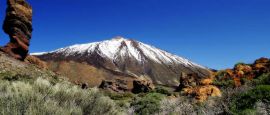Tenerife History, Language and Culture
History of Tenerife
Although territorially belonging to Spain, Tenerife and the Canary Islands have many similarities to the Americas. Before their invasion by the Spanish in the 15th century, the islands were populated by a race of fishermen and farmers probably related to the North African Berbers.
The new settlers quickly planted sugarcane which thrived in the tropical climate of the north of Tenerife and soon brought financial rewards. A near-perfect climate, an alluring landscape and the prospect of new horizons attracted merchants, artisans and holy orders in their droves. In the 17th century, when the sugar trade was undercut by cheaper production in the Antilles, vines were planted and Tenerife's Malmsey wine became the best in the world.
Strategically placed at the crossroads between Europe and the New World, Tenerife became a frontier land, grown rich with the spoils of trade and a constant target for every brigand, pirate and navy man working in the Atlantic Ocean, including one Admiral Nelson who lost his arm during an unsuccessful attempt on the capital in 1797.
But when market forces drove crops into decline and hunger followed, it was to the new American colonies that much of the population fled, seeking work and an escape from hunger. It was Tinerfeños (natives of Tenerife) who, in the 19th century, founded the cities of Montevideo in Uruguay and San Antonio in Texas. Others fled to Cuba and Argentina, returning to their homeland once they’d made their fortunes.
In the late 19th century banana production was introduced to Tenerife and remains the largest single food export, its giant leaves adorning plantations across the island. In economic terms, however, agriculture has long since played second fiddle to the new cash crop of tourism.
In 1936 when a commander-in-chief of the Spanish army was suspected of plotting to overthrow the government, he was posted to Tenerife as Governor of the Canary Islands to keep him out of the way. The plan didn't work, and it was from here that General Francisco Franco launched his offensive that began the Spanish Civil War.
Did you know?
• As part of his annual salary, William Shakespeare was paid with one barrel of wine from Tenerife.
• The whodunnit writer Agatha Christie wrote much of The Mystery on the Blue Train while holidaying in Tenerife.
• Queen’s hit song Tie Your Mother Down was written by Brian May while he was studying astronomy in Tenerife.




 You know where
You know where